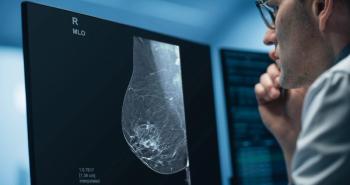
Early Study Shows Optical Metabolic Imaging May Detect Early Breast Cancer Response
Optical metabolic imaging may not only identify breast cancer subtypes, but may also detect early breast cancer treatment responses.
Optical metabolic imaging (OMI) can identify acute breast cancer subtypes and detect treatment response after two days, according to a study published in the journal
Using a custom-built, multiphoton microscope coupled with a titanium-sapphire that causes nicotinamide adenine dinucleotide (NADH) and flavin adenine dinucleotide (FAD) to emit fluorescence, researchers from Vanderbilt University in Nashville, Tenn., isolated the fluorescence of NADH and FAD using special filters. They then measured the ratio of the two as “rodox ratio.”
Comparing normal and cancerous breast cells under a microscope, the researchers were able to differentiate between signals of the two cells, as well as between estrogen receptor-positive, estrogen receptor-negative, HER2-positive, and HER2-negative breast cancer cells.
The researchers were also able to identify the effect of the anti-HER2 antibody trastuzumab on three breast cancer cell lines and in human breast tumors grown in mice. Tumors in the live mice imaged by OMI demonstrated a difference in response between trastuzumab-sensitive and -resistant tumors as early as two days after the first dose of the antibody.
"Cancer drugs have profound effects on cellular energy production, and this can be harnessed by OMI to identify responding cells from nonresponding cells," researcher Alex Walsh said. "We are hoping to develop a high-throughput screening method to predict the optimal drug treatment for a particular patient."
Walsh is a graduate student in Vanderbilt’s biomedical engineering department.
While OMI can be used on tissues freshly excised from patients, the investigators say that it could be incorporated into endoscopes for live imaging of human cancers.
Newsletter
Stay at the forefront of radiology with the Diagnostic Imaging newsletter, delivering the latest news, clinical insights, and imaging advancements for today’s radiologists.




























